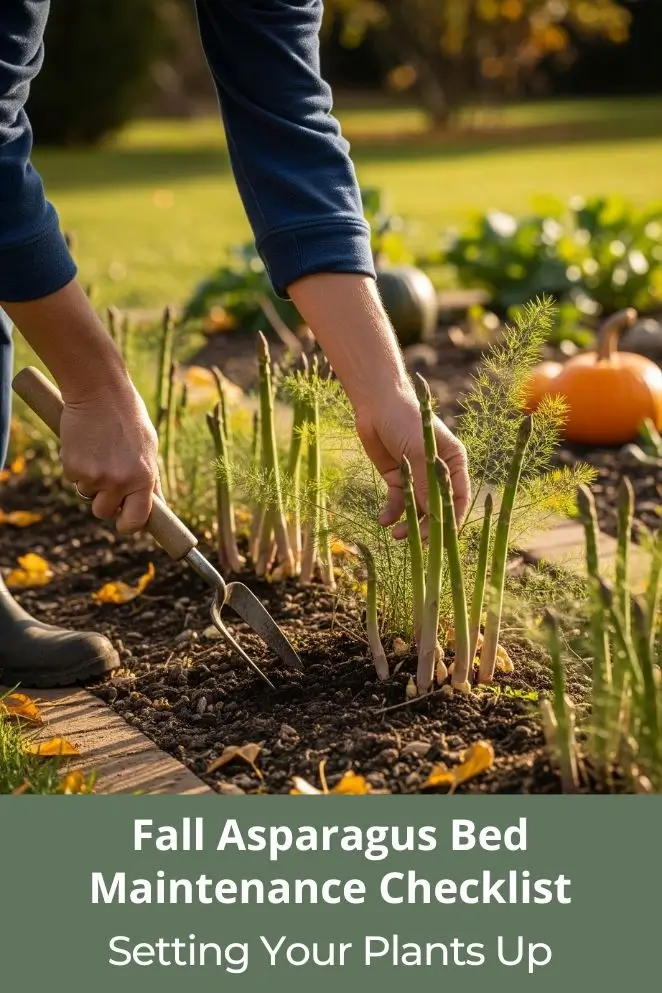
As autumn rolls in, your asparagus bed is basically clocking out from summer and getting ready for its winter nap.
What you do now decides if it wakes up strong next spring or just limps along.
Asparagus isn’t a “one-and-done” crop—it’s a long-term garden buddy that can stick around for 15–20 years if you treat it right.
Fall care is about feeding the crown (the plant’s underground battery) so it’s fully charged for next season.
This guide breaks down exactly what to do to keep your patch healthy, happy, and ready to pump out fat, tasty spears when spring hits.
Essential Fall Maintenance Tasks
1. Watch for natural die-back
When to start: Wait until the plants go yellow on their own
Patience is key here. Don’t go full Edward Scissorhands the second you see green stalks still standing tall.
Let your asparagus fronds yellow naturally—this usually happens after the first few light frosts.
That yellowing is the plant’s way of pulling energy from its fronds back down into the crown (the underground “battery” it uses to power next year’s growth).
If you cut too early, you’re basically yanking away its power source mid-charge. Green = still making food, so hands off until the plant says it’s ready.
2. Cut back dead foliage
When to do it: Once everything’s yellow or brown and crispy
Now you can grab the shears. Once your asparagus is totally brown, it’s safe to chop the stalks down to about an inch or two above the soil.
Clean, sharp cuts are best—don’t hack at it like you’re fighting zombies.
Pro tips:
- Healthy plants? Toss that cut foliage into the compost pile.
- Pest problems during the season? Don’t risk it—bag it up and send it to the trash.
- Warmer climates? Some asparagus won’t fully die back, so you’ll need to eyeball each frond and decide when it’s done working.
3. Weed patrol and bed cleanup
Priority level: High (like, don’t skip this)
Fall is prime time to go after weeds. With your asparagus trimmed back, you can see everything clearly and yank out freeloaders before they steal food and water.
Weeding strategy:
- Pull the big ones by hand, root and all (half-pulling just guarantees a comeback tour).
- For small weeds, a stirrup hoe is your best friend.
- If you’re cool with chemicals, a pre-emergent herbicide works too (but follow the directions like your garden depends on it).
- Clear out any diseased plant bits so pests don’t get a cozy winter hideout.
A clean bed = healthier asparagus + fewer bugs next spring.
4. Feed the soil, feed the plant
When to do it: Mid to late fall
Asparagus is a heavy eater, and fall is when you “meal prep” for next spring.
Think of compost and fertilizer as packing the fridge for the long winter.
What to add:
- 2–4 inches of compost or composted manure around the crowns
- A balanced organic fertilizer (10-10-10 type works fine)
- Bone meal for phosphorus = strong roots
- If your soil pH is too high (above 7.0), sprinkle in some sulfur—these plants prefer 6.0–7.0
How to do it:
- Spread everything evenly across the bed
- Work it gently into the top couple inches of soil with a rake
- Be careful not to mess with the crowns—they’re shallow and don’t like being poked around
5. Mulching for winter protection
Essential for: Every climate, no excuses
Mulch is like a winter blanket for your asparagus bed—it keeps the crowns cozy, blocks weeds, locks in moisture, and protects against those nasty freeze-thaw cycles that can wreck roots.
How to do it right:
- Pile on 3–4 inches of organic mulch across the whole bed
- Best stuff to use? Straw, shredded leaves, or wood chips (basically garden pajamas)
- Don’t smother the crowns—leave a 2–3 inch gap so they don’t rot
- Spread it evenly so sneaky weeds don’t get any sunlight
Regional hack: If you live way up north where snow’s your winter reality, some gardeners leave the dead asparagus fronds standing so they can trap snow. Snow = free insulation for your crowns.
6. Winterizing your irrigation system
Critical if your winters actually freeze
Got an irrigation setup? Don’t let Jack Frost crack your pipes. Winterizing now saves you from buying expensive replacements in spring.
Steps:
- Shut off the water supply to that zone
- Drain every line and sprinkler head like you’re emptying a juice box
- Take off any parts that might freeze and stash them indoors
- Mark where the sprinkler heads are so you’re not playing hide-and-seek next spring
7. Pest and disease check-up
Always important, but fall is cleanup season
Don’t let bugs and diseases hibernate in your asparagus bed like freeloaders. Fall is when you evict them.
The usual suspects:
- Asparagus beetles: The classic villains. If you saw them hanging around this year, mow those ferns down to the dirt so they’ve got nowhere to crash over winter.
- Cutworms: Tiny stem-chompers. You can fight back with beneficial nematodes (basically microscopic soil ninjas).
- Rust diseases: If you see orangey-brown spots, pull those plants and toss them—don’t risk keeping them around.
Prevention hacks:
- Clear all plant debris—bugs and diseases love a messy room
- Encourage “good guy” bugs by planting flowers nearby (ladybugs, lacewings, etc.)
- Rotate crops in surrounding beds so pests don’t get too comfy year after year
8. Crown division planning
For older beds: every 3–4 years
Think of asparagus crowns like a band that’s been touring too long—eventually, they get overcrowded and tired. That’s when it’s time to split them up and give them more space to thrive.
Signs it’s time:
- Spears getting thinner and weaker every season
- Plants crowding each other like a packed subway car
- Bare patches where crowns just gave up and died
- Old beds (15+ years) losing their spark
What to do:
- Mark the spots now so you’re ready to divide in early spring
- Order new crowns if you want to expand your patch
- Prep fresh soil in another spot if you’re moving divisions out
Regional Timing Considerations
Here’s the thing: asparagus doesn’t care about your calendar—it cares about your weather.
Your climate zone basically sets the pace, so don’t just copy what someone in another state (or country) is doing.
Northern regions (Zones 3–5):
- You’ll usually see die-back kick in around mid to late October—those ferns will yellow like old notebook paper.
- Get your cutting done by early November, before snow turns your bed into a frozen mystery zone.
- Mulch before the ground locks up solid, otherwise you’re basically tucking in your asparagus with a sheet of ice instead of a blanket.
Moderate climates (Zones 6–7):
- Here, die-back usually happens in November.
- If your plants are dragging their feet, you can push cutting back into early December. I’m in zone 6b, and honestly, I don’t usually get around to cutting mine until the end of November. (Procrastination sometimes pays off in gardening!)
- Bonus tip: use those mild winter days for weeding. It’s easier when the soil’s soft and you’re not freezing your fingers off.
Southern regions (Zones 8–9):
- Your asparagus might be that overachiever who doesn’t want to quit—some fronds stay green-ish all season.
- Instead of following the calendar, just pay attention to how the plants look. If they’re still working, let them keep working.
- Your main job? Don’t rush it. Wait until the fronds are done-done, not just “kinda tired.”
Long-Term Bed Health Strategies
Okay, so here’s the secret no one tells you: asparagus isn’t just a one-season fling, it’s a long-term relationship.
If you treat your bed right, it’ll keep feeding you for 15–20 years—basically longer than some friendships.
Fall isn’t just cleanup time, it’s also when you set yourself up for the long game.
Soil health management
- Think of soil tests like a check-up at the doctor. Every 3–4 years, you wanna know if your soil’s pH and nutrients are still on point.
- Keep adding organic matter on a schedule. Compost, manure, leaves—it’s like giving your asparagus a steady diet instead of junk food binges.
- Drainage is non-negotiable. If water pools, asparagus crowns will rot. (It’s like leaving sneakers in the rain—gross and avoidable.)
Bed expansion and renewal
- Plan to slowly expand your patch so you can stretch out harvests over time.
- Old beds eventually tire out, so think ahead about starting new ones.
- And hey, don’t get boring—toss in some new varieties now and then. Diversity makes your garden more resilient and more fun.
Integrated pest management
- Roll out the red carpet for the good bugs—ladybugs, pollinators, parasitic wasps. A few flowers nearby can turn your asparagus bed into bug paradise.
- Don’t plant the same annual veggies in the same spot year after year. Mix it up so pests don’t feel like they’ve got a permanent buffet.
- Keep an eye on regional pest gossip. (Gardeners are basically detectives—always watching for the next culprit that could mess with their plants.)
Common Fall Maintenance Mistakes to Avoid
Look, asparagus is tough, but it’s not indestructible.
Mess up your fall routine, and you’ll pay for it next spring when your patch looks sad and underfed.
Here’s the stuff beginners (and even seasoned gardeners) get wrong all the time—and how to dodge those traps.
Premature cutting
Don’t go Edward Scissorhands on your asparagus too early.
If the fronds are still green, they’re still working—pumping energy into the roots for next year.
Cutting early is like making your plant quit its job before payday.
Over-fertilization
Yes, asparagus is hungry, but dumping too much nitrogen in the fall is a rookie move.
All it does is force the plant to push out soft, juicy growth that winter will absolutely wreck.
Think of it like binge-eating right before running a marathon—you’ll just cramp up.
Inadequate mulching
Skimp on mulch and you’re basically leaving your asparagus bed naked in a snowstorm.
Thin mulch = more weeds + crowns freezing.
Always go for a thick, cozy layer—straw, shredded leaves, wood chips, whatever you’ve got.
Ignoring drainage
Waterlogged soil is the silent killer here.
If you’ve ever left sneakers outside in the rain and found them moldy the next day—you get the picture.
Crowns sitting in soggy soil = crown rot city. Fix drainage before winter locks everything in place.
Pest habitat creation
Don’t be that gardener who leaves diseased fronds or brush piles hanging around.
That’s like building a five-star hotel for asparagus beetles and other freeloaders.
Clean up, toss infected stuff in the trash, and don’t give pests a place to party all winter.
Conclusion
Do your fall asparagus chores and you’re basically investing in future meals — little effort now, big payoff next spring.
Start when the fronds naturally die back, be patient (don’t rush the cutting), fix soil, mulch, and boot pests — consistent care = fatter spears and fewer headaches later.
Think long-term: asparagus rewards gardeners who show up every fall.
I’ve ignored mulch once and paid for it with sad, thin spears the next year — don’t be me. Do the checklist, adapt to your zone, and your bed will thank you with decades of tasty harvests.



